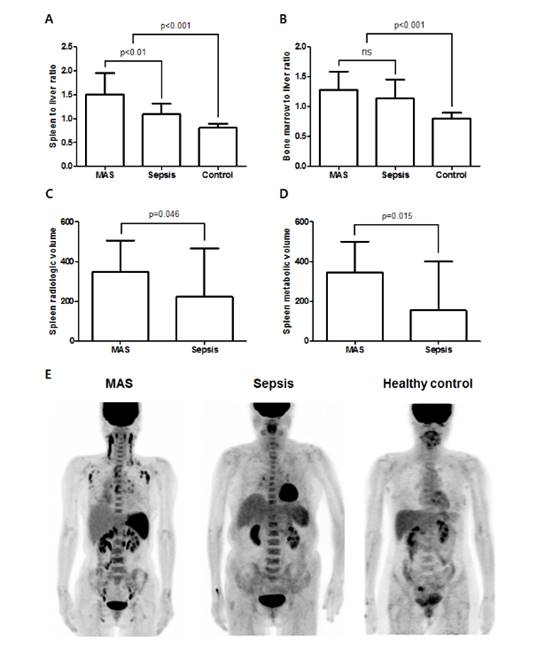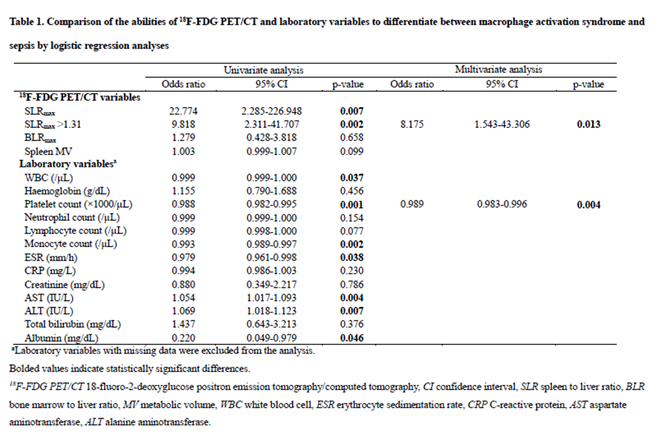Session Information
Session Type: ACR Poster Session A
Session Time: 9:00AM-11:00AM
Abstract
Background/Purpose: To evaluate splenic glucose metabolism in macrophage activation syndrome (MAS), characterised by overwhelming systemic inflammation. Splenic 18F-fluorodeoxyglucose (FDG) uptake was compared in patients with MAS and sepsis using positron emission tomography/computed tomography (PET/CT).
Methods: Clinical and FDG-PET/CT findings from patients with MAS and those with culture-proven sepsis were evaluated. Standardised uptake value (SUV) for the spleen and liver were measured. The maximum of the spleen to liver SUV ratio (SLRmax) was calculated as spleen SUVmax/liver SUVmean. Radiological splenic volume was also measured, and splenic metabolic volume (MV) was defined as total splenic volume with an SLRmean > 1.14. The association between clinical features, laboratory variables, and SLRmax was analysed.
Results: The median SLRmax and splenic MV were significantly higher in patients with MAS (n = 38) than they were in those with sepsis (n = 15) (SLRmax: 1.51 vs. 1.09, p = 0.001; MV: 346.0 vs. 154.0, p = 0.015) (Figure 1). Multivariate analyses revealed that SLRmax > 1.31 was useful for discriminating between MAS and sepsis (Table 1). SLRmax positively correlated with ferritin and lactate dehydrogenase level in MAS. Furthermore, MAS patients with high splenic FDG uptake (SLRmax >1.72) had higher in-hospital mortality compared to those with moderate to low splenic FDG uptake (p = 0.013).
Conclusion: This study was the first to demonstrate that splenic FDG uptake is significantly elevated in patients with MAS compared to those with sepsis. This may be useful to differentiate between MAS and sepsis, and to predict poor prognosis in patients with MAS.
References
1. Rosado FG, Kim AS. Hemophagocytic lymphohistiocytosis: an update on diagnosis and pathogenesis. American journal of clinical pathology. 2013;139(6):713-727.
Figure. 1 Comparison of the standardised 18F-fluorodeoxyglucose uptake values (SUV) in patients with macrophage activation syndrome (MAS; n = 38), patients with sepsis (n = 15), and healthy controls (n = 40) (A) The SUVmax of spleen to liver ratio. (B) The SUVmax of bone marrow to liver ratio. (C) Spleen radiologic volume. (D) Spleen metabolic volume. (E) Representative 18F-FDG PET/CT images in patient with MAS (left), patient with sepsis (middle), and healthy control subject (right). ns, not significant. Data are expressed as the median; error bars indicate the interquartile range.
To cite this abstract in AMA style:
Ahn SS, Hwang SH, Jung SM, Lee SW, Park YB, Yun M, Song JJ. The Clinical Utility of Splenic Fluorodeoxyglucose Uptake for Diagnosis and Prognosis in Patients with Macrophage Activation Syndrome [abstract]. Arthritis Rheumatol. 2017; 69 (suppl 10). https://acrabstracts.org/abstract/the-clinical-utility-of-splenic-fluorodeoxyglucose-uptake-for-diagnosis-and-prognosis-in-patients-with-macrophage-activation-syndrome/. Accessed .« Back to 2017 ACR/ARHP Annual Meeting
ACR Meeting Abstracts - https://acrabstracts.org/abstract/the-clinical-utility-of-splenic-fluorodeoxyglucose-uptake-for-diagnosis-and-prognosis-in-patients-with-macrophage-activation-syndrome/


